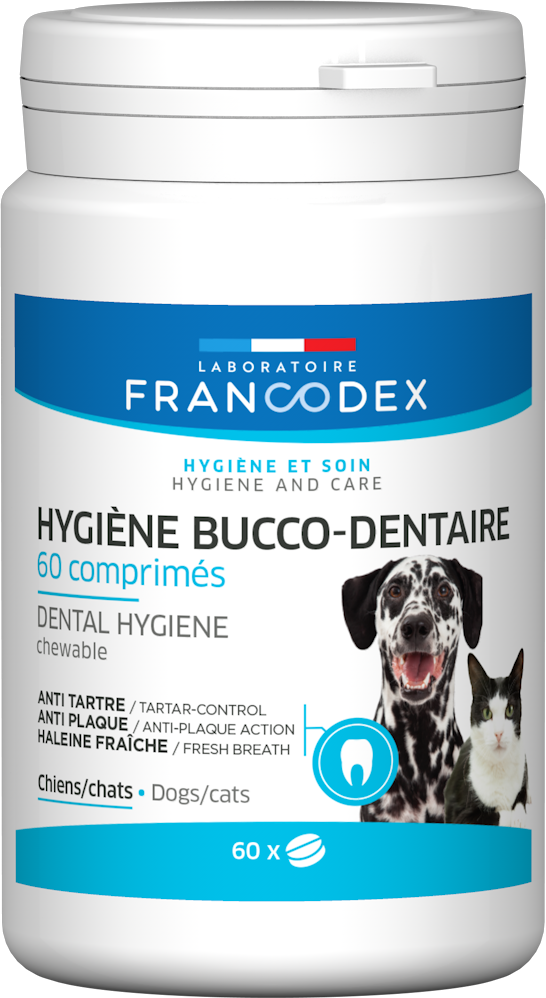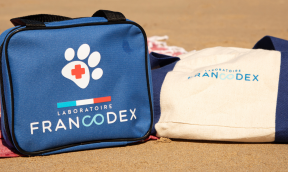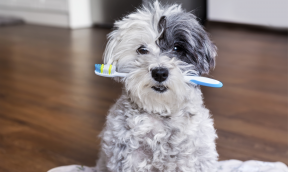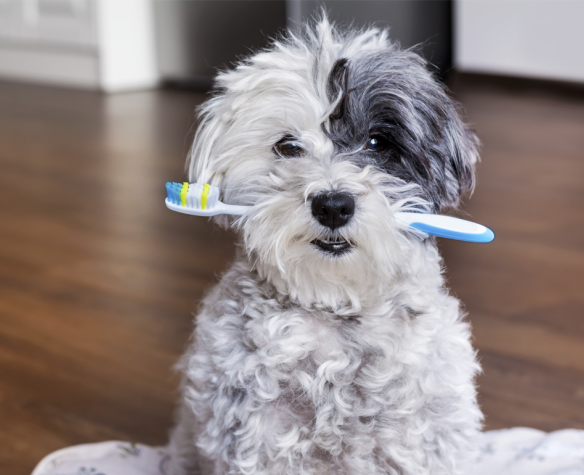
Oral hygiene for dogs: everything you need to know
Oral hygiene for dogs: not to be taken lightly!
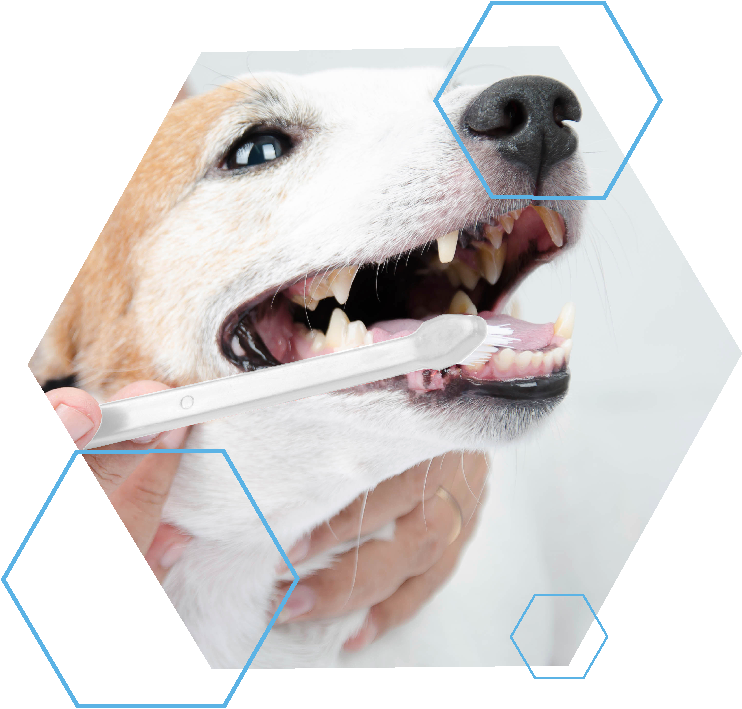 Does your dog have bad breath? That is not at all surprising as some dogs can suffer from problems related to dental plaque and tartar from only 2-3 years of age. This includes bad breath. However, you can reverse the situation by improving your dog’s oral hygiene. The best way? Take care of your dog’s teeth from a very young age. Find out how to maintain your pet’s oral hygiene, even if your dog will not let you brush his teeth!
Does your dog have bad breath? That is not at all surprising as some dogs can suffer from problems related to dental plaque and tartar from only 2-3 years of age. This includes bad breath. However, you can reverse the situation by improving your dog’s oral hygiene. The best way? Take care of your dog’s teeth from a very young age. Find out how to maintain your pet’s oral hygiene, even if your dog will not let you brush his teeth!
How to maintain good oral hygiene for your dog?
Like humans, dogs need good oral hygiene to protect their teeth and gums and prevent certain oral diseases.
Several solutions exist for controlling tartar, dental plaque and problems such as bad breath. These are part of the daily care essential for your pet.
Your dog’s diet also plays a role in supporting good oral health. Dog’s teeth are made to chew. You should therefore offer him a mixed diet comprising premium biscuits with a composition and texture helping to “pre-clean” his teeth, while ensuring he is getting essential fluids.
If you do not clean your dog’s teeth, he could have to undergo descaling under general anaesthesia. This is much more inconvenient and stressful than simply brushing your dog’s teeth each day!
How to maintain good oral hygiene for your dog?
Nowadays, good oral hygiene for dogs is straightforward, as numerous cleaning solutions are available. Laboratoire Francodex offers several products to meet the requirements of owners and their dogs. One of our oral hygiene solution will undoubtedly be suitable for your pet!
BRUSHING YOUR DOG’S TEETH
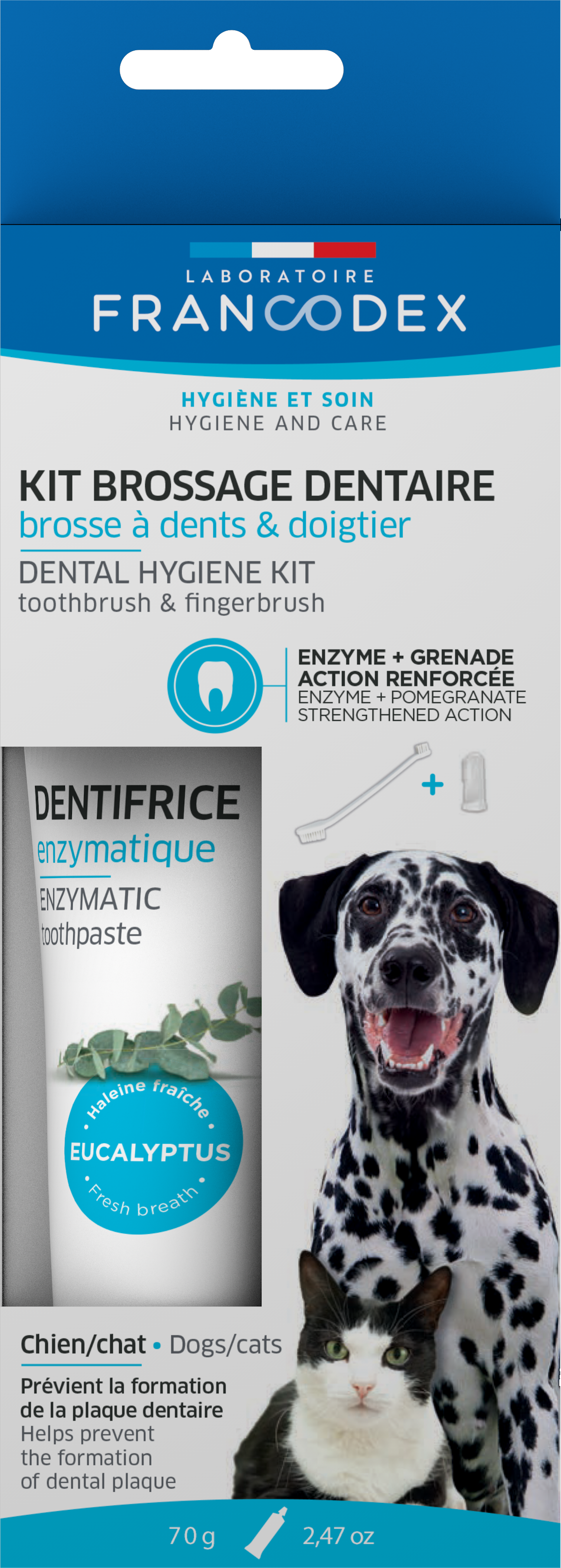 Brushing teeth is still the most effective method for maintaining good oral hygiene for your dog.
Brushing teeth is still the most effective method for maintaining good oral hygiene for your dog.
A toothbrush and toothpaste kit for dogs allows you to clean your pet’s teeth daily. It will be easier to brush his teeth if he becomes accustomed to this from a young age.
🐾Are you familiar with medical training? This technique aims to teach your pet to let you check his paws, muzzle, ears and his whole body, so as to reduce stress during veterinary appointments. Maintaining good oral hygiene is a medical training action. Your pet will learn to wait while you clean his teeth and inspect his mouth. He will then be more willing to open his mouth if he needs to be examined by a veterinary surgeon.
CHEW STRIPS
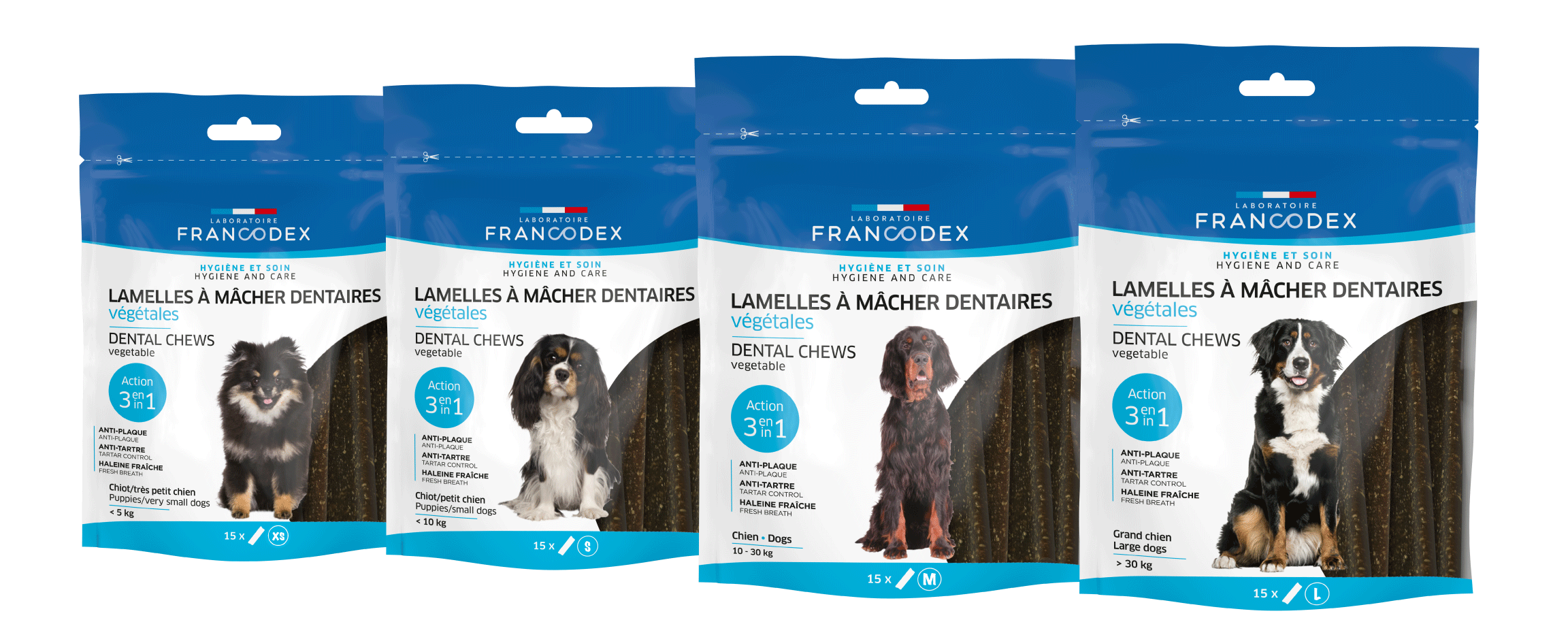
Chew strips are one solution for maintaining your pet’s oral hygiene, while keeping him occupied with what he thinks is simply a chew treat. Owing to their abrasive texture and specifically designed “Z” shape, these chew strips stimulate chewing and clean teeth mechanically.
🐾 NB: if your dog is suffering from an oral disorder, he might refuse to take a chew strip. In this case, you should without a doubt seek veterinary advice.
You can give your dog a chew strip daily or alternate this with tooth brushing. Complete oral hygiene normally includes brushing accompanied by chew strips. The chew strips act due to their abrasive properties upon chewing, which is not guaranteed to clean all of his teeth.
Choose the chew strips based on your dog’s weight:
- chew strips for dogs weighing less than 5 kg prone to stress ;
- chew strips for dogs weighing less than 10 kg;
- chew strips for dogs weighing less than 10 kg prone to stress ;
- chew strips for dogs weighing 10 to 30 kg;
- chew strips for dogs weighing 10 to 30 kg prone to stress ;
- chew strips for dogs weighing more than 30 kg;
- chew strips for dogs weighing more than 30 kg prone to stress
Oral treats also freshen the breath and may be fed as a supplement instead of a traditional treat, to combine practicality with pleasure! For small dogs weighing less than 10 kg, opt for specially adapted oral treats.
DENTAL CARE FOR DOGS TO BE ADDED TO WATER OR FOOD
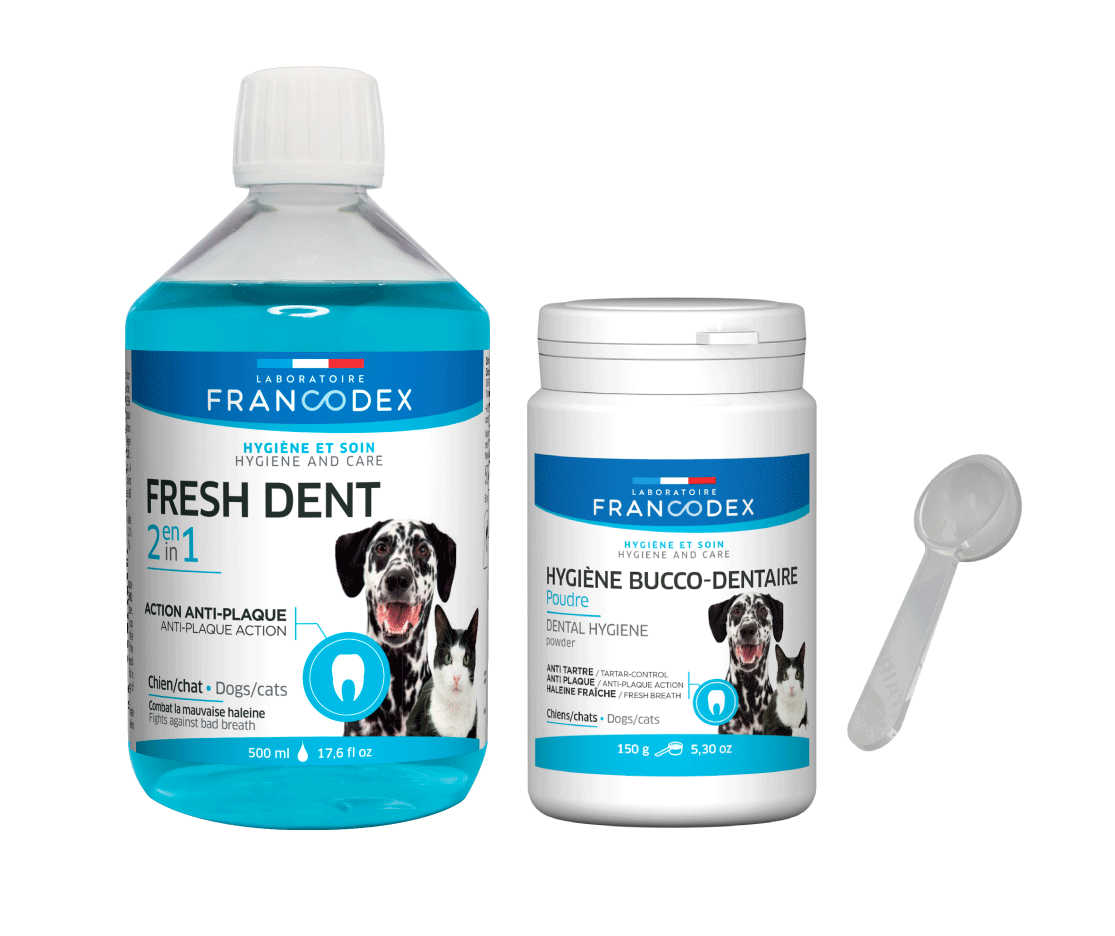
Does your dog refuse to let you brush his teeth or eat chew strips? No problem. He might prefer a dental solution with an anti-plaque action added to his water or food. Containing pomegranate extracts, this liquid formula acts on dental plaque, tartar and bad breath.
Dental powder is another option which can be added to your dog’s food. Made from brown algae, fructo-oligosaccharides and sodium bicarbonate, dental powder for dogs helps control dental plaque. It can also treat the digestive cause of bad breath.
ORAL CARE FOR DOGS TO CONTROL BAD BREATH
Is your dog relatively reluctant to accept any oral hygiene care? A relatively stress-free alternative is available for your dog: breath freshener spray. It is applied directly onto the teeth and gums, and prevents the build-up of dental plaque and tartar while strengthening the gums.
This noiseless spray is accepted by even the most fearful dogs.
OTHER PRODUCTS TO MAINTAIN ORAL HYGIENE FOR DOGS
Your pet might be willing to let you brush his teeth daily or regularly use chew strips.
However, if you go on holiday, you might appreciate a travel-friendly solution. In this case, chewable toothpaste is a good option. Pet owners appreciate its fresh breath effect.
How can you train your dog to let you brush his teeth?
If you have never brushed your pet’s teeth before, start by getting him used to a toothbrush and toothpaste. Place a pea-sized amount of toothpaste on your finger and rub his gums gently. Dogs find toothpaste highly appetising. They should normally enjoy it and see it as a treat.
Then, once your dog lets you rub his gums with your finger, try a finger brush. It has a rougher texture and will have a more effective cleaning action than your finger. It is particularly recommended for exclusive use in puppies as the dog toothbrush can sometimes be too large.
Lastly, when your dog is comfortable with this daily oral hygiene routine, start using the brush. Brush as best you can, but ideally from the gum to the tip of the tooth, to avoid pushing bacteria under the gum. If your dog allows you to do so, pay particular attention to the back teeth where tartar builds up faster compared to the incisors and canine teeth at the front.
You should brush your dog’s teeth at least every two or three days. You should ideally clean his teeth daily.
🐾Tip: introduce your dog to the brushing method from a very young age. Otherwise, you might struggle to make him accept this oral hygiene routine.
Does bad breath always mean poor oral hygiene?
No, your dog can suffer from bad breath due to digestive issues affecting the stomach or intestine.
If your dog has bad breath despite proper oral hygiene, the best solution would be to visit your veterinary surgeon for a reliable diagnosis.
Which dog breeds are more prone to oral problems?
As is the case for most diseases and conditions affecting dogs, not all breeds are equal when it comes to tartar build-up and the development of periodontal disease.
Small dog breeds are most at risk, such as Yorkshire terriers, bichons, shih tzus or chihuahuas. Domestication of dogs, in fact, led to morphological changes in their oral cavity, with flatter muzzles for example. This partly explains the development of dental plaque and tartar build-up due to changes in how dogs feed and chew.
🐾 Useful information: just because your dog might not be susceptible to the effects of tartar build-up, this does not mean that he will not develop oral problems! Good oral hygiene is important for all breeds and all dogs.
What are the specific dental and digestive characteristics of dogs?
Dogs’ oral anatomy and physiology are different to humans. Firstly, their dentition is characteristic of carnivores, with carnivorous teeth designed to cut up but to a lesser extent to grind food. Chewing is brief, which has an impact on digestion.
Dogs are not particularly prone to caries, but rather to the build-up of dental plaque. The build-up of dental plaque contributes to tartar formation which causes bad breath and gum damage.
Dental plaque can ultimately lead to bacterial infection and the development of periodontal disease characterised by:
- painful chewing;
- excessive tartar-build up on teeth;
- very inflamed gums;
- abscesses or tooth loss in more serious cases.
If your pet has a lot of tartar, red gums or difficulty eating, see your veterinary surgeon promptly. If a problem is treated early on, treatment is more straightforward with faster recovery. Your dog could thus avoid a descaling procedure! And if descaling is necessary, you should then adopt good oral hygiene habits to avoid the need for descaling too frequently.
You are now aware of most of the solutions available to help you maintain your dog’s oral hygiene. If your pet refuses to let you brush his teeth, or if you have just taken in a dog who has never been trained to have his teeth brushed, you will need a whole lot of patience, but you must not give up.
Dogs can learn to accept new treatments at any age. By taking care of his oral hygiene, this will help keep your pet’s teeth healthy for longer to continue living life to the full!
Article drawn up with the assistance of
Dr Stéphanie PADIOLLEAU, Veterinary Surgeon

